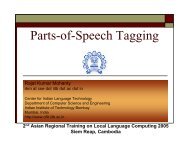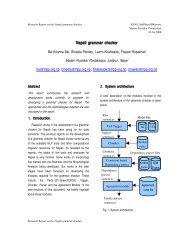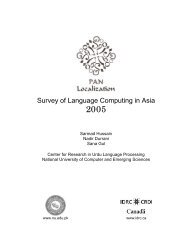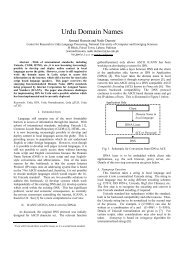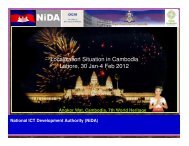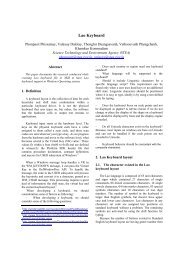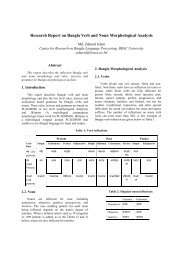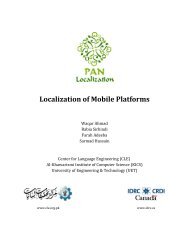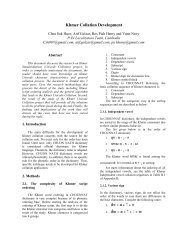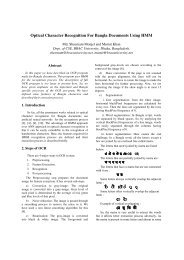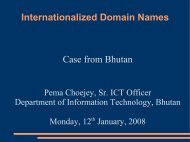A Survey on Script Segmentation for Bangla OCR
A Survey on Script Segmentation for Bangla OCR
A Survey on Script Segmentation for Bangla OCR
You also want an ePaper? Increase the reach of your titles
YUMPU automatically turns print PDFs into web optimized ePapers that Google loves.
Å<br />
Æ<br />
Ç<br />
Ç<br />
Ë<br />
Bengali<br />
handwritten <strong>Bangla</strong> numerals [2-4], but very few<br />
research works have been found <strong>on</strong> overall<br />
handwritten <strong>Bangla</strong> <strong>OCR</strong> [5].<br />
Per<strong>for</strong>ming a survey <strong>on</strong> several government,<br />
semi-government, public and private organizati<strong>on</strong>s<br />
it has been found that more than 80% of their<br />
important documents, that should to be stored safely<br />
<strong>for</strong> a l<strong>on</strong>g period of time, are in printed <strong>for</strong>m.<br />
Though currently most (about 90%) of these printed<br />
<strong>Bangla</strong> documents are computer composed, but the<br />
trend of computer composed <strong>Bangla</strong> documents is<br />
new in <strong>Bangla</strong>desh. In previous days, most of the<br />
<strong>Bangla</strong> documents (about 80%) used to be printed<br />
using type-machine.<br />
So c<strong>on</strong>sidering our present needs and available<br />
resources it is better skip thinking of <strong>OCR</strong> <strong>for</strong><br />
<strong>Bangla</strong> handwritten scripts. Rather, it would be<br />
much more useful if an efficient <strong>OCR</strong> <strong>for</strong> <strong>Bangla</strong><br />
printed scripts (of course, it is off-line) can be<br />
developed. Here, it is to menti<strong>on</strong> that as most of the<br />
old and important documents in our country are<br />
type-machine composed, more priority <strong>for</strong> the<br />
precisi<strong>on</strong> of recogniti<strong>on</strong> rate of the type-machine<br />
composed documents can be imposed up<strong>on</strong> the<br />
target <strong>OCR</strong> system.<br />
3. Properties of Different <strong>Bangla</strong> <strong>Script</strong>s<br />
<strong>Bangla</strong> scripts are moderately complex<br />
patterns. Unlike simple juxtapositi<strong>on</strong> in Roman<br />
scripts, each word in <strong>Bangla</strong> scripts is composed of<br />
several characters joined by a horiz<strong>on</strong>tal line (called<br />
‘Maatra’ or head-line) at the top [6]. Of-ten there<br />
may be different composite characters and vowel<br />
and c<strong>on</strong>s<strong>on</strong>ant signs (‘Kaar’ and ‘Falaa’ symbols)<br />
[7-8]. This makes the development of an <strong>OCR</strong> <strong>for</strong><br />
<strong>Bangla</strong> printed scripts a highly challenging task.<br />
There are some basic features or properties of<br />
any <strong>Bangla</strong> printed script.<br />
i. Writing style of <strong>Bangla</strong> is from left to<br />
right.<br />
ii. The c<strong>on</strong>cept of upper and lower case (as in<br />
English) is absent here.<br />
iii. Am<strong>on</strong>g the characters, the vowels often<br />
take modified shapes in a word. Such<br />
characters are called modifiers or<br />
allographs [7-9] (in <strong>Bangla</strong> ‘Kaar’).<br />
C<strong>on</strong>s<strong>on</strong>ant modifiers are possible (called<br />
‘Falaa’). These are shown respectively in<br />
Table 1a and Table 1b.<br />
iv.<br />
Table 1a: <strong>Bangla</strong> vowels and their modifier<br />
<strong>for</strong>ms<br />
Vowel Corresp<strong>on</strong>ding Vowel Modifier<br />
B<br />
Â<br />
C<br />
D<br />
E<br />
F<br />
G<br />
H<br />
I<br />
J<br />
K<br />
Ã<br />
Ä<br />
È<br />
É<br />
È Â<br />
È Ê<br />
Table 1b: <strong>Bangla</strong> c<strong>on</strong>s<strong>on</strong>ants and their<br />
modifier <strong>for</strong>ms<br />
C<strong>on</strong>s<strong>on</strong>ant<br />
e<br />
f<br />
f<br />
k<br />
Corresp<strong>on</strong>ding C<strong>on</strong>s<strong>on</strong>ant<br />
Modifier<br />
å<br />
In a single syllable of a word, several<br />
c<strong>on</strong>s<strong>on</strong>ant characters may combine to <strong>for</strong>m<br />
a compound character that partly retains<br />
the shape of the c<strong>on</strong>stituent characters (e.g.<br />
Na + Da, Ka + Ta, Va + Ra-falaa, Na +<br />
Daa + Ra-falaa shown in Table 2) [7-9].<br />
Table 2: <strong>Bangla</strong> c<strong>on</strong>s<strong>on</strong>ants and their modifier<br />
<strong>for</strong>ms<br />
Compound<br />
Formati<strong>on</strong> of the Character<br />
Character<br />
° _ + X<br />
w<br />
L + V<br />
Ð<br />
c + ç<br />
² _ + ] + ç<br />
v. Except very few characters and symbols<br />
(e.g. Ae, Oy, O, Ow, Kha, Ga, Ungo, Nio<br />
etc), almost all <strong>Bangla</strong> alphabets and<br />
symbols have a horiz<strong>on</strong>tal line at the upper<br />
part called ‘maatra’. Some are shown in<br />
Fig.1a.<br />
vi. In a word, the characters with ‘maatra’<br />
remain c<strong>on</strong>nected together through their<br />
‘maatra’ and other characters and symbols<br />
(e.g. Kh<strong>on</strong>dota, Bishorgo, Ungo, Ae, Oy<br />
V<br />
132




